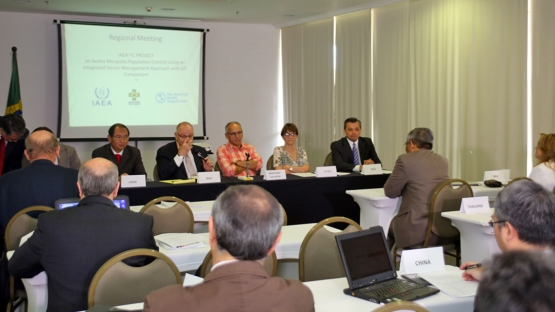At a meeting this week organized by the International Atomic Energy Agency (IAEA) in Brasilia, Brazil, representatives from 18 Latin American countries met to review vector control options as Zika outbreaks continue to rise in the region.
“The idea is to bring together representatives from the most affected regions to share the tools we have available, such as SIT, so that they can make use of these to address the Zika problem” said Raul Ramírez García, a Section Head of the IAEA’s Latin American and Caribbean Division in the Technical Cooperation Department.
The meeting, taking place in the Brazilian capital from 24-26 February 2016, is part of the Agency’s efforts to share knowledge on how nuclear techniques can contribute to international actions against Zika. It follows a meeting earlier this week where experts reviewed the Sterile Insect Technique (SIT) as a key component in any integrated strategy to control disease vectors.
According to the World Health Organization (WHO), Zika transmission has been reported in 28 countries and territories, the vast majority of which in Latin America.1 The spread of the virus within the geographical range of the mosquito is considered likely.
“We have a worrying situation in Mexico because we have not been able to control the Aedes population using current methods such as spraying” says meeting participant Ildefonso Fernandez Salas, Director of the Regional Public Health Research Centre (CRISP). “We have 82 reported cases of Zika for now, and are here to explore the SIT technology as a preventive measure for the future.” Mexico already uses SIT to manage fruit fly populations, and is gearing up to test the application of the technique in mosquitos.
Zika virus has been associated with serious birth defects, and although the evidence linking neurological disorders to the virus remains circumstantial, WHO says a growing body of data points towards a connecting role. In Brasilia this week, WHO’s head Margaret Chan said the world must consider the Zika “guilty until proven innocent.”
The Aedes aegypti mosquito is also responsible for the transmission of debilitating diseases such as Dengue fever – which affect millions of people in Latin America – and Chikungunya. In the absence of vaccines or cheap and effective medications against these sicknesses, the control of the vector is essential in order to protect the public.
“Costa Rica has a history of dengue fever – we’ve had over 300,000 cases since 1993. Since 2014 we have cases of Chikungunya and as of last week 2 confirmed Zika virus cases, so it’s just a matter of time until this becomes a problem in our country” said Rodrigo Marin Rodriguez, National Chief for Vector Control in the country. “We are open to the alternative methods presented here, such as SIT or the combined SIT and Incompatible Insect Technique using the Wolbachia bacteria, so this meeting is very useful. We would be keen to test these in Costa Rica to assess its cost-benefit,” he added.
The IAEA Board of Governors will review a project, which will require 2.3 million Euro in funding, during its March 2016 session to help Latin American countries strengthen their capacity to control the Aedes mosquito. The meeting in Brasilia this week is a preparatory step towards the implementation of this project.
1 http://www.paho.org/hq/index.php?option=com_content&view=article&id=11669&Itemid=41716&lang=en
We have 82 reported cases of Zika for now, and are here to explore the SIT technology as a preventive measure for the future.



